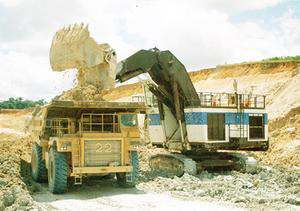That the foreboding clouds of declining global demand and receding world market prices are not sufficient to persuade the Government of Guyana to give up on the future of bauxite as a major money-earner for the country’s economy was the underlying theme of last Wednesday’s address at a centennial symposium for the bauxite industry.
At a forum which might well have been regarded in some quarters as a channel for nostalgic reflections on a passing era and a requiem for a commodity that played a major role in the creation and consolidation of one of the country’s most socially and politically significant communities, Trotman announced, seemingly to the surprise of many that government is setting up an expert Bauxite Sectoral Review Committee.

The task of the committee, which begins work in November, will include assessing the industry and offering recommendations for the feasibility of an alumina plant. The committee, which will be headed by two of the best-known names in the sector, E Lance Carberry and Sylvester Carmichael, is expected to conclude its work by February 2017. Trotman said Carberry and Carmichael will be supported in their work by representatives of the Regional Administration of Region 10, the Guyana Bauxite and General Workers Union (GBGWU), and the Guyana Geology and Mines Commission (GGMC). He said that “given the national significance of this exercise” the government will also be seeking the participation of the political opposition.
Arguably, the real significance in Trotman’s announcement is located in the potential it could have for lifting the notion of a bygone era that appeared to have settled over discourses on the bauxite industry in relatively recent years. The presence here of Chinese and Russian investors in the bauxite industry had been largely seen in terms of the winding up of a sector which, in its time, had served Guyana well but was now in the throes of slipping quietly into retirement.
And with public and political discourse having long settled into a vibrant debate over the future of Linden beyond bauxite, the Natural Resources Minister may well have taken steps to push that discourse in an entirely different direction by his announcement that “research has confirmed that there is an average of 100 more years left in the region’s reserves,” a calculation which he said was a “positive for residents of Region 10 and all Guyanese.”

Apart from making recommendations “for regulatory and other changes to enhance the GGMC’s operations vis-à-vis bauxite exploration and production,” Trotman told the forum that the high level technical team has also been assigned the task of commissioning of a feasibility study for mine development and the construction of an international scale alumina refinery in Linden “as part of the strategy to forward integrate the bauxite industry while transforming the economy of Region 10.”
And if declining demand and prices have taken their toll on the industry Trotman’s presentation still sought to deal with the theme of revival rather than requiem. He noted that between 2005 and 2014 the bauxite industry had “benefited from more than US$180 million in capital investment” and that for all its travails the sector currently provides direct employment for more than 1,000 persons.
Going forward, Trotman said the Canadian bauxite company, First Bauxite Corporation, having been granted a 50-year land lease through its local subsidiary, Guyana Industrial Minerals Inc has completed and submitted a technical report on the feasibility study for the Bonasika Proppant Project in Essequibo. If approved, it would be Guyana’s third bauxite mine in operation.
And according to Trotman 2016 has thus far seen an increase in production of bauxite by some 38,000 tonnes as at September 30, compared with the same period last year. Bauxite production for this year so far has reached 1,138,182.80 tonnes.









